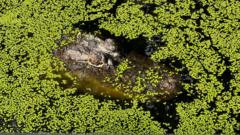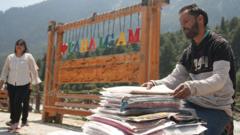The number of saltwater crocodiles in Australia’s Northern Territory has rebounded from near extinction to an estimated 100,000, raising significant concerns regarding public safety. With fatal incidents occurring sporadically, the government has introduced a management plan that increases the annual culling quota. In balancing conservation with human safety, local rangers emphasize education and responsible coexistence while grappling with emerging tourism and economic interests.
Navigating the Crocodile Conundrum in Australia's Northern Territory

Navigating the Crocodile Conundrum in Australia's Northern Territory
As saltwater crocodile populations surge in Australia’s Northern Territory, authorities face a challenging balancing act between conservation efforts and public safety concerns.
In Australia’s Northern Territory (NT), the saltwater crocodile population is flourishing after facing near extinction. Once dwindling to around 3,000 due to unchecked hunting post-World War Two, the species has rebounded dramatically following a hunting ban in 1971. With current estimates placing their numbers around 100,000, the NT finds itself at a crossroads, grappling with how to safely coexist with these apex predators.
On a typical day in Darwin Harbour, government ranger Kelly Ewin prepares to catch crocodiles, vigilant for a potentially dangerous encounter. His mission is to remove crocs, particularly during the breeding season when they become increasingly active. Despite having only several incidents resulting in fatalities in recent years, the NT government has started to bolster culling efforts. A new 10-year management plan allows for a significant increase in the number of crocodiles that can be killed, raising the quota from 300 to 1,200 annually.
Public safety is a priority, according to experts like Professor Grahame Webb. He warns about the dangers of people becoming hostile towards crocodiles, which could lead to hasty political decisions aimed at addressing the "crocodile problem." The NT government is also investing in educational programs such as “Be Crocwise,” aimed at teaching locals and tourists how to navigate waterways safely and reduce risky interactions.
Conservation efforts maintain that crocodiles are a protected species, and mass culling is not presently on the agenda; however, the situation is complex. The debate intensifies with every incident involving the reptiles, igniting public discourse around the balance of livelihoods and safety. With the NT's population around 250,000, significantly less than that of the crocodiles, officials like then-leader Eva Lawler emphasized that human safety takes precedence.
Moreover, the economic aspects of crocodile management cannot be overlooked. Crocodile farming has emerged as a lucrative industry, supplying luxury fashion brands that utilize crocodile skins. In collaboration with Aboriginal groups, farmers like Mick Burns aim to promote sustainable practices. However, there remains opposition against the conditions in which captive crocodiles are kept.
The presence of crocodiles has become a major draw for tourists in the NT, with attractions showcasing croc jumping and other wildlife encounters. Yet, the inherent dangers cannot be ignored; experts warn that swimming in croc-infested waters poses significant risks. Continual efforts are being made to manage the coexistence of humans and these formidable creatures, ensuring the safety of residents while leveraging the economic potential of crocodile-related tourism and conservation initiatives. The challenge remains, emphasizing the need for ongoing dialogue and strategic management in the face of rising crocodile populations.

















